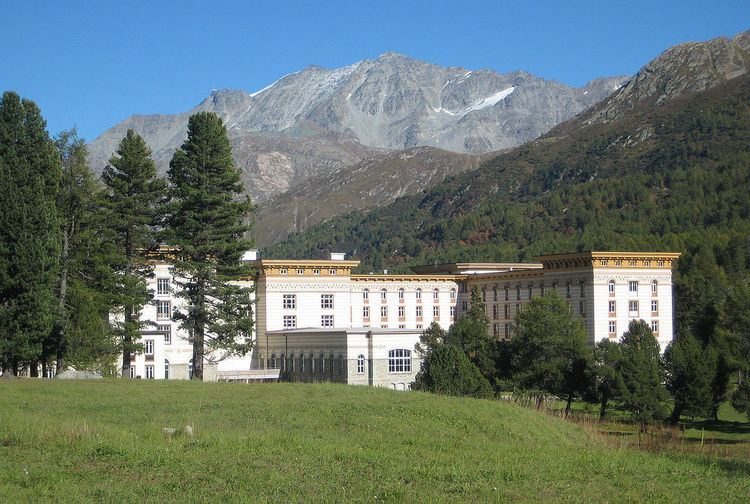Floor count 4 Architect Kuoni and Jules Rau | Opening 1884 Floor area 18,800m2 Number of rooms 130 | |
 | ||
The Maloja Palace is a hotel 15 km (9.3 mi) from St Moritz, in the Graubünden canton of Switzerland, at the top of the Maloja Pass (Italian: Passo del Maloja, German: Malojapass) (el. 1815 m.) linking the Engadin and the Bregell valley, very close to the village of Maloja a hamlet in the municipality of Bregaglia in the Maloja District.
Contents
History
Camille Maximilien Frédéric, count of Renesse (9 July 1836 – 12 June 1904), built the hotel following the designs of Belgian architects Kuoni and Jules Rau in a Neo-Renaissance style; building commenced in 1882 and the hotel was opened on 1 July 1884. Initially called "Hôtel Kursaal de la Maloja" it was renamed "Maloja Palace", becoming the first hotel to bear the name "Palace" at its time and the biggest and most modern hotel in the Alps.
The E-shaped building had five floors with a central cushion-domed roof, curved windows heads for ground and top floors relieve an overall barrack-like appearance, as do the colored frieze on a horizontal string-course in common with many more palace hotels at the outbreak of the Great War. Originally had 300 rooms and about 450 beds as well as 20 public rooms, two enormous dining rooms and an equally large ballroom possessing a small stage where, as part of the luxurious lifestyle intended to be on display, two concerts a day were given in summer months with musicians from the orchestra of La Scala.
The Maloja Palace had electricity and elevators, which were very modern at its time, an air refreshment system enhanced by the addition of ozone (early air conditioning), nine-hole golf course, two tennis courts and a darsena for rowing and sailing boats on Sils lake. However, the hotel went bankrupt only five months after opening as cholera had broken out in neighbouring Italy just four days after its opening.
Among its many famous guests, the hotel records mention Jean Hennessy, the count Ferdinand von Zeppelin (inventor of the rigid dirigible), Walter Rothschild, Arturo Toscanini, Clementine Churchill, Sarah Bernhardt, Sir Arthur Conan Doyle father of (Sherlock Holmes), Prussian prince Ludwig Yorck von Wartenburg, Russian prince Kotchoubey, Esterházy family and painters like Giovanni Segantini and Alberto Giacometti who painted "Paysage à Maloja: le lac de Sils et le Maloja Palace" ca 1920.
Until 1934 where crisis forced its closure, the hotel subsequently reopened with various owners. In following decades the gigantic hotel served the Swiss Army which held there refresher courses. The building suffered removal of central cushion-domed roof and lost its attractiveness.
In 1962 the hotel was owned by the Holiday Hotel Maloja AG, in which the Belgian health insurance scheme Mutualités chrétiennes (also known as Christelijke Mutualiteit in Dutch), the largest health insurance organisation in Belgium with 4,5 million members, had a majority holding. It leased the hotel complex to the Intersoc operating company, organizing since the summer of 1949, holidays in Switzerland at affordable prices for affiliates of Mutualités chrétiennes trying to give them an introduction to the alpine world and its inhabitants, and acquire some familiarity with the means of travel in mountain regions both in summer and in winter.
In the 1980s, its bookings steadily decreased as a result of the unpopularity of large, military-like establishments and the cancellation of the night train between Brussels and Chur. Like other Belgian health insurance schemes, Mutualités chrétiennes ran into financial difficulties caused in part by high renovation costs.
In January 2006 the Italian entrepreneur Amedeo Clavarino bought the Maloja Palace and, after extensive renovation work, it reopened in 2009 as a four-star hotel with 50 suites and 130 rooms, a wellness centre, a ballroom and dining rooms for 700 people. As part of the reopening, to coincide with the 125th anniversary of its first opening, a performance of The Barber of Seville (Gioachino Rossini) took place in the hotel lobby, as part of the St. Moritz Summer Opera Festival.
Every winter, on the second Sunday of March, the Engadin Skimarathon competition, the biggest skiing event in the Alps, attracting between 11,000 and 13,000 cross-country skiers each year, starts at the entrance of the hotel.
A typography font called "Maloja Palace" was created in 2003 by Nick Curtis following the design of a 1930s luggage tag signed by Brügger, A.G. - Meiringen.
